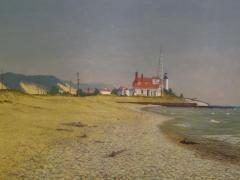The house Armand and Betty lived in was rarely repaired. A repairman banging around the house would disturb him. Betty never complained. Five children were born during the first ten years: twin daughters, René and Michele, in 1951; a son, Mark, in 1953; and daughters, Chantal, in 1957 and Aimé in 1960.
After the birth of the twins, Betty suffered from rheumatic fever and was bedridden for nearly a year. Armand cared for her and the babies as much as he could along with help from Betty’s mother. During this time Armand adopted a bushy beard and wore a jaunty beret, seldom appearing in public or print without a fat, assertive cigar.
Betty was devoted to Armand. His work mattered most to her. She believed in it. She did her best to support him and his quirky ways. He liked to work during the night and sleep well past noon. In the daytime, she did her best to keep their inquisitive youngsters quiet. When their exuberance seemed disruptive she’d say, “Come on, let’s go outdoors and do something.” Or, “Let’s go down the basement. Let’s be quiet. Daddy’s sleeping.” She recalls, “It was difficult—but, you know, we got through it and it was all great. He loved the children. He loved our family and was totally devoted to them. But yet he had this pull and this need to create. Those two things are sort of at odds with each other. The challenge was trying to keep the conditions right” (Dornbush/Zandstra Interview with Betty Merizon, 6-21-04).
Daughter Michele recalled, “That’s how our life was lived. To support his artwork. I mean it was when you wake up in the morning, where he was, what he was doing. We had to be quiet certain times if he was awake. When he was sleeping we had to be quiet and when he was awake he had to concentrate. She had to have a lot of control over us. She’s the glue really that held the whole family together. We all adore her, that’s why we call her ‘The Beauty’. She enabled my father to concentrate on his artwork and do what he had to do and she, with five children, managed us pretty well. She’s just closest to an angel as there can be” (Dornbush/Zandstra Interview with René Merizon/Ludema, 6-23-04).
LeeAnne Kinnee says of Betty: “She’s just love personified. And love in a way that we all would hope to reach. Patience, kindness, acceptance, non-judgmentalness, and on and on and on. And yet she’s so grounded” (Dornbush/Zandstra Interview with Lee Ann Kinnee, 6-24-04).
Although notices of Armand’s awards in local, regional, and national art contests brought him invitations by civic groups to lecture about art, his income from commissions, sales, and prizes could not meet expenses. Hence, the family was forced to survive on borrowed funds and bartered services.
In April of 1954 he chaired the seventh annual West Michigan Artists Show, a major exhibition held in the Grand Rapids Art Gallery. At the time he created a public fuss by withdrawing as judge until prize categories were divided equally between representational and abstract styles. “To take a truly successful work in either field and say that one is exclusively superior to the other is being arbitrary,” he told the local paper. “The ideal person will, in alternate moods, enjoy them both” (VanderMey, 2012).
In published letters to the editor of the Grand Rapids Press, he later continued to battle for appreciation of representational art and of excellence in any style. His tone was intellectually vigorous, sometimes pompous, sometimes defensive, sometimes sneering, and sometimes magnanimous.
That same year, near desperation, Armand agreed to become informal artist-in-residence at a tourist haven in Frankfort, Michigan, an attractive town on the shores of Lake Michigan, southwest of Traverse City. A developer offered to rent him housing which Armand was expected to repay from the proceeds of his paintings. At first the plan and the setting seemed utopian. From the fall of 1954 to the summer of 1955, Armand, Betty, and their three toddlers enjoyed life there—until it became an economic grind. He couldn’t sell any paintings in Frankfort, and the corporation never did what it had promised to do—advertise and promote Armand’s work. In the end in order to pay the rent and other expenses Armand was forced to take weekly trains with one or more of the children to Grand Rapid and peddle his oils at cut-rate prices. After a year Armand repaid all but fifty-five dollars. He withdrew from utopia feeling frustrated and cheated and moved back to Grand Rapids. At the time he couldn’t help but think of Adan DeRyke who was forced into commercial work after well-healed customers refused to buy his paintings unless they were a “good deal.”
Business men would often say to Armand: “‘Well, now, you've got to make some money. Instead of a big painting like that, that kind of price, why don't you make a whole bunch of little ones that are appealing and put them up in a restaurant or something and sell them.’ See, that's what we call the bromos.”




